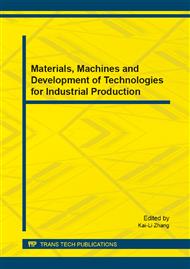[1]
C. R. Woses, W. G. Weisburg, B. J. Paster, The phylogeny of purple baeteria: the alpha subdivision, Systematic and Applied Microbiology. 3 (1984)327-336.
DOI: 10.1016/s0723-2020(84)80035-1
Google Scholar
[2]
W. Deboer, P. J. A. K. Gunnewiek, M. Veenhuis, Nitrification at low pH by aggregated chemolithotrophic bacteria, Applied and Environmental Microbiology. 57 (1991) 3600-3604.
DOI: 10.1128/aem.57.12.3600-3604.1991
Google Scholar
[3]
Z.P. Liu, S. J. Liu, Advances in the molecular biology of nitrifying microorganisms, Chin J Appl Environ Biol. 4 (2004)521-525.
Google Scholar
[4]
J. L. Hu, X. G. Lin, H.Y. Chu, Isolation of soil ammonia- oxidizing bacteria, Soils. 5 (2005)569-57l.
Google Scholar
[5]
J. Yu, M. Yang, R. Qi, J. Zhou, Community structures of ammonia-oxidizing bacteria in different municipal wastewater treatment systems, Acta Scientiae Circumstantiae. 3 (2009)521-526.
Google Scholar
[6]
D. Werner, W. E. Newton, Nitrogen Fixation in Agriculture Forestry, Ecology and the Environment, 1st ed., Netherlands, Springer. (2005)255-276.
Google Scholar
[7]
K. C. Chen, S. J. Chen, J. Y. Houng, Improvement of gas permeability of denitrifying PVA gel beads, Enzyme Microb Technol. 18 (1996)502-506.
DOI: 10.1016/0141-0229(95)00160-3
Google Scholar
[8]
C.J. Lu, C.M. Lee, C.Z. Huang, Biodegradation of chlorophenols by immobilized pure-culture microorganisms, Wat Sci Technol. 34 (1996)67-72.
Google Scholar
[9]
H. S. Seung, S. C. Suk, P. Kyungmoon, J. Y. Young, Novel hybrid immobilization of microorganisms and its applications to biological denitrification, Enzyme Microb Technol. 37 (2005)567-573.
DOI: 10.1016/j.enzmictec.2005.07.030
Google Scholar
[10]
Tsung H. H., Yu J. F. and Chun M. H., PVA-alginate immobilized cells for anaerobic ammonium oxidation (anammox) process, J Ind Microbiol Biotechnol. 35, (2008)721-727.
DOI: 10.1007/s10295-008-0336-7
Google Scholar
[11]
H. Zhang, P. J. Li, X. M. Hu, Screening and cultivation conditions of two Nitrosobacteria strains, Environmental Protection of Chemical Industry. 26 (2006)366-369.
Google Scholar
[12]
J. L. Zheng, J. W. Li, Screening and preliminary identification of several strains of Nitroso-bacteria, Shanghai environmental science. 21 (2002)291-322.
Google Scholar
[13]
X. L. Wu, J. G. Liu, Study on sodium alginate and poly vinyl alcohol as entrapping agents, Environmental science. 2(1993)28-311.
Google Scholar


